 |
Russian Fort Elizabeth
Kauai, Hawaii, USA
|
|
 |
Constructed: 1817
Used by: The Russian-American Company, Kingdom of Hawaii
Also known as: форт Елизаветь,
Fort Hipo
Conflicts in which it participated:
None
|
Was Russian Fort Elizabeth actually Russian in any meaningful way? Though not built or used by actual Russians, it was built by a German, at what he thought, mistakenly, was the behest of some Russians. There we go, just thought we'd get that clarified at the outset.
|
 |
|
|
Russians may have landed on what is today Alaska as early as 1648, and small expeditions of Russian fur traders were regularly sailing back & forth across the Bering Strait by the 1740's. Between 1733 and 1867 Russian settlements existed in modern California and Alaska, as well as at two ports in Hawai'i. Russian America pretty much consisted of Alaska, though tendrils of Russianosity reached through much of the Pacific.
|
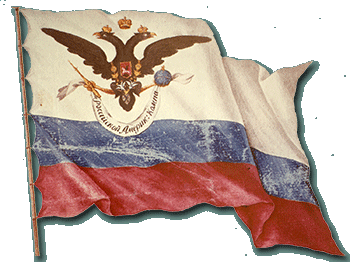 The flag of the Russian-American Company, 1806 pattern. The flag of the Russian-American Company, 1806 pattern. |
 |
Tsar Paul I (1754-1801), interested in spreading those tendrils as far as possible, chartered the Russian-American Company (RAC) in 1799. This organization was expected to establish further settlements in Russian America, and promote and aid in colonization. While this may sound ominous today, at the end of the 18th century settlin' 'n' colonizin' was a major priority of every European power.
Much of the RAC's interest in Hawaii was that island chain's potential to be utilized as a resupply stop for trans-Pacific voyaging. The RAC first reached Hawaii in 1804, during Russia's inaugural circumnavigation of the earth. At this time they made contact with Hawaiian King Kamehameha I (1736-1819), with whom they made trade agreements (or so they thought). |
|
The Bering, an RAC ship carrying a valuable cargo of furs, ran aground on the island of Kauai in 1815. The Bering's captain made arrangements with Kaumualii (1778-1824), the King of the island of Kauai, to protect the ship and cargo until the RAC could return to collect the cargo, whereupon Kaumualii would get to keep the (wrecked and likely useless) ship. Kaumualii naturally absconded with the ship and cargo, and the RAC began discussing the merits of a punitive expedition to get it's cargo back, in addition to killing lots of people.
|
Enter Georg Anton Schäffer (1779-1836). Born in Germany and expelled from a Russian ship on which he served as surgeon, Schäffer was taken on by the RAC in 1813. Though untrained in diplomacy, Schäffer must have been an impressive fellow, because the RAC sent him to Hawaii following the seizure of the Bering, to weasel his way into the good graces of King Kamehaha (the putative ruler of all the Hawaiian islands) with the ultimate goal of retrieving the lost cargo or payment for same.
Schäffer did in fact meet King Kamehaha in November of 1815, and succeeded in gaining his trust by performing some medical services on the Great Man and his Queen. On behalf of the RAC, Schäffer started diplomatic talks with King Kaumualii in 1816. If King Kamehaha had been impressed by Schäffer, King Kaumualii practically bore him children, so voluminous was that king's appreciation of Schäffer and all things RAC!
|
 |
 Georg Anton Schäffer. He meant well. Georg Anton Schäffer. He meant well. |
|
Kaumualii personally raised an RAC flag over Kauai, proclaiming eternal fealty to the Russian-American Company, or Tsar Alexander I (1777-1825), or to whomever Mr. Schäffer might suggest was worthy of proclaiming fealty. Kaumualii signed a treaty that promised 500 local soldiers to the RAC should they wish to invade and take over the rest of the Hawaiian Islands, and went so far as to suggest that Hawaii might serve as a Russian "protectorate." Sugarplum visions of Russian conquest, with himself, dressed as an Admiral, galloping at the head of the charge on an armored flaming voodoo elephant, danced behind Schäffer's eyes.
Kaumualii also assigned 300 laborers to Schäffer, who utilized these willing hands and backs to build three forts on Kauai: Fort Alexander (named of course for the Tsar) and Fort Barclay-de-Tolly (named for Prince Michael Andreas Barclay de Tolly (1761-1818), a Russian general and Minister of War during Napoleon (1769-1821)'s invasion of 1812) were two small earthen forts, but the jewel in Schäffer's dreamily potential Hawaiian crown was Fort Elizabeth.
|
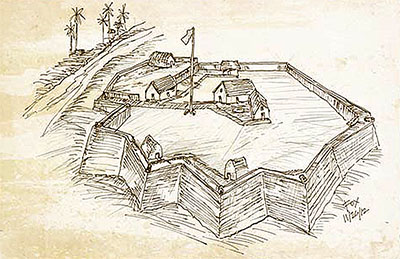 A 2012 drawing of Russian Fort Elizabeth when it actually looked like a starfort. Seems to me kind of like Fort Putnam in West Point, New York. Thanks, "Fox!" A 2012 drawing of Russian Fort Elizabeth when it actually looked like a starfort. Seems to me kind of like Fort Putnam in West Point, New York. Thanks, "Fox!" |
 |
Named for Elizabeth Alexeievna (1779-1826), Tsar Alexander's wife, Fort Elizabeth was constructed on the east bank of the Waimea River overlooking Waimea Bay in 1817. Fort Elizabeth was built of stone and adobe, measuring about 450 feet by 300 feet in size, with 20-foot-high walls. With five actual bastions jutting off into the west and south, the fort had a total of eight defensible points.
A small Russian Orthodox chapel was built within Fort Elizabeth's walls, which was Hawaii's first Orthodox Christian church. The fort also contained a magazine, armory, barracks and "sandalwood trading house." |
|
Yes sir, Schäffer had successfully laid the groundwork for the Imperial Russian ownership of Hawaii! As some of us may have foreseen, however, King Kaumualii's enthusiasm for Russian intervention in the region was slightly less than genuine...and the royal shenanigans of Hawaii were no less convoluted and nefarious than those of Europe. Bent on obtaining Hawaii for himself, Kaumualii would have cheerfully signed any manner of treaty with anyone who might help him achieve his goal. While he had completely convinced Schäffer that Russia and the RAC would benefit vastly from this arrangement, Tsar Alexander, fortunately, did not have his head up his own posterior.
Once the Tsar finally learned of Schäffer's Hawaiian scheme in mid-1817, he wasted no time in admonishing the Russian-American Company, and Schäffer, after a few fruitless attempts to stand his ground amidst increasingly hostile Hawaiians and a number of Americans, who had an interest in seeing the Russians on their way, was retrieved from Hawaii, relieved of his job with the RAC and sent back to Germany.
|
King Kamehameha remained the ruler of all the Hawaiian Islands, but Kaumualii was also "ruler" of the islands of Kauai and Niihau, which are Hawaiian Islands. Was Kaumualii like a state governor, under president Kamehameha? It is unlikely that Kaumualii felt this to be the case, but regardless, he did command Fort Elizabeth in 1820 when his son, Humehume (1798-1826), returned home: We know this because the guns of Fort Elizabeth (known by this point as Fort Hipo) provided a 21-gun salute when the Thaddeus, upon which sailed Humehume, arrived in Waimea Bay on May 3, 1820. Unsure of the intended meaning of this gunfire, Humehume remained belowdecks until it was made clear that this was a salute, not a warning.
|
 |
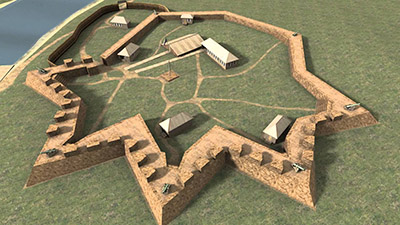 A still from a ten-second YouTube video, of a 3D rendering of Fort Elizabeth in her glory days. See? it really was a starfort! A still from a ten-second YouTube video, of a 3D rendering of Fort Elizabeth in her glory days. See? it really was a starfort! |
|
Humehume was no pantywaist. He had spent several years in the United States, where he had served in the US Marine Corps during the War of 1812 (1812-1815). Humehume was wounded in the battle betwixt the USS Wasp and HMS Reindeer in the English Channel in June of 1814, and in 1820 was returning home in the hope of claiming his father's throne and increasing that kingdom's domain.
|
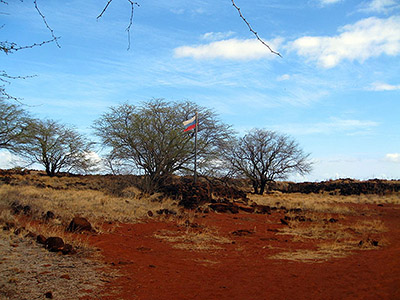 The singularly unimpressive interior of Fort Elizabeth today, still flying the Russian flag. The singularly unimpressive interior of Fort Elizabeth today, still flying the Russian flag. |
 |
On August 8, 1824, Humehume led a small group of followers in an attempt to capture Fort Elizabeth. Upon entering the fort he began shouting in victory, which did not rouse the throngs of supporters to his cause, but instead alerted the garrison to trouble, and he and his party were expelled from the premises.
The Kingdom of Hawaii sent a thousand troops to Kauai, a force that was based at Fort Elizabeth, to capture Humehume and wipe out his rebellion. Humehume's camp was found, attacked and routed to the tune of 130 dead rebels, the largest loss of life to military conflict on Hawaii until the Japanese attack on Pearl Harbor in December of 1941. Humehume and his family escaped into the hills.
|
|
But not for long! Humehume evaded capture for a few weeks, but was eventually captured, his life spared, and exiled to Honolulu (Hawaii's Siberia), where he was reunited with his family. "Exiled" to one of the most gorgeous and hospitable places on earth with his wife and child! Such torture!
|
No longer deemed necessary for the security of Kauai, Fort Elizabeth was officially dismantled by the Kingdom of Hawaii in 1864, following an 1862 inventory of the fort's armaments. This inventory included: - 16 swords
- 60 flintlock muskets
- 12 18-pounder cannon
- 26 4 and/or 6-pounder cannon
- 6 "heavy" guns
- 24 "little" guns
"Little" guns? Why bother attempting to accurately identify any guns if you can just refer to them as "big" or "little?" This inventory was compiled by Valdemar Knudsen (1819-1898), a Norwegian who would go on to pioneer in the sugarcane plantation business on Kauai, but who did not, regrettably, go into the lucrative accurate armament inventorying trade. Hawaii was made a United State in 1959, and Fort Elizabeth was named a National Landmark in 1966. Today the crumbling fort resides in Fort Elizabeth State Historical Park, which provides bathrooms to the weary traveler. |
 |
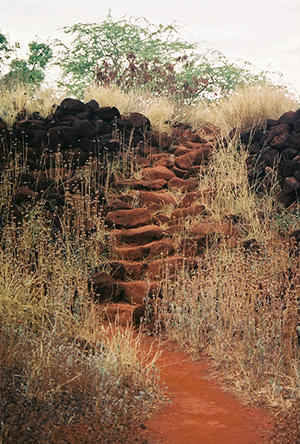 Stairs to For Elizabeth's mighty terreplein. Stairs to For Elizabeth's mighty terreplein. |
|
Many, many thanks to Jacob Bogle and his Fortress Earth project, through which I discovered Russian Fort Elizabeth! |
|
|
|
|
|
 |




